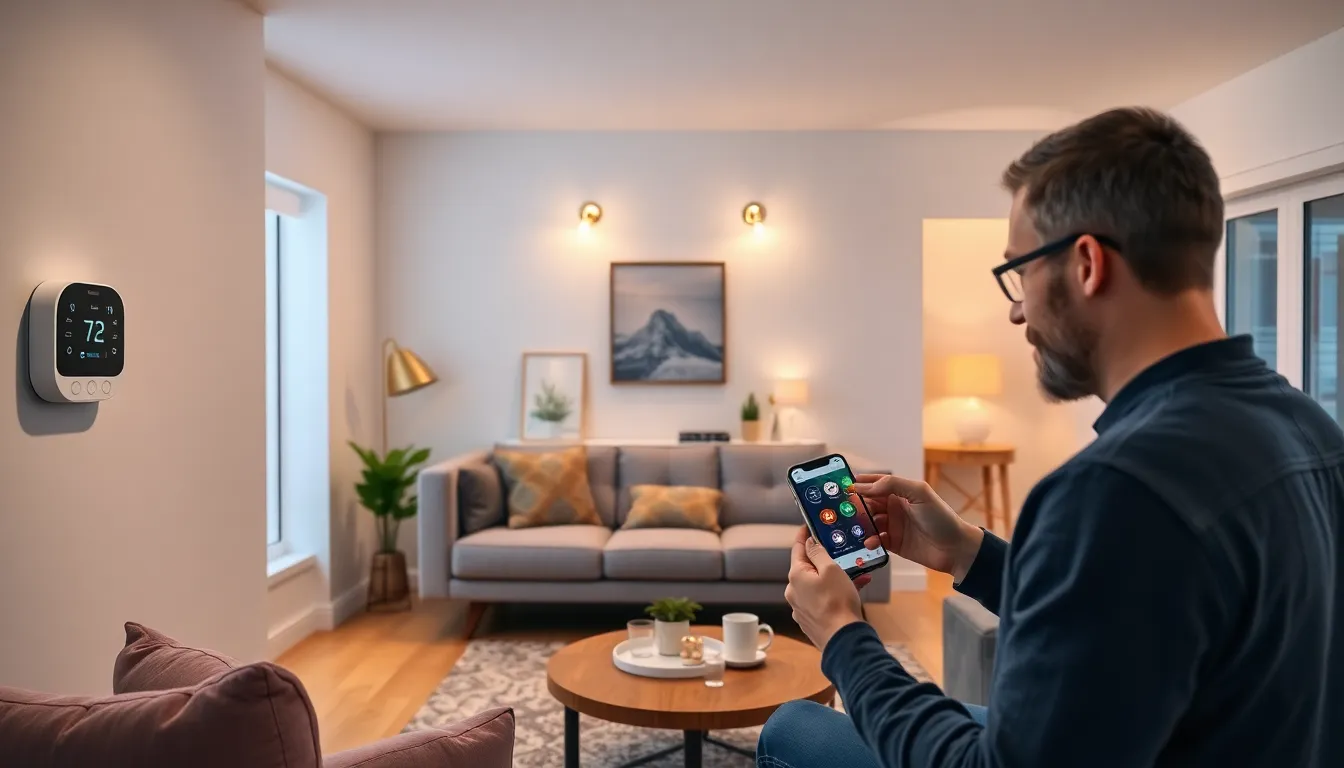Table of Contents
ToggleImagine walking into your home and having it greet you like an old friend. With smart home electrical installation, that dream can become a reality. It’s not just about convenience; it’s about transforming your living space into a tech-savvy haven that’s as efficient as it is stylish. Who wouldn’t want to control their lights, thermostat, and even coffee maker from the comfort of their couch?
Overview of Smart Home Electrical Installation
Smart home electrical installation integrates advanced technology into residential settings. This setup allows seamless communication between devices, enhancing energy efficiency and comfort. Room lighting can adjust automatically based on occupancy, ensuring lights only illuminate when needed. Smart thermostats optimize heating and cooling, potentially resulting in 10-15% savings on energy bills.
Homeowners enjoy greater control through mobile apps. These apps can schedule events, such as turning on the coffee maker or adjusting blinds, creating a personalized environment. Security features often include smart locks and cameras, enabling remote monitoring. Enhanced surveillance helps protect properties against intruders.
Wireless communication technologies play a crucial role in these installations. Zigbee, Z-Wave, and Wi-Fi act as the backbone for device connectivity, ensuring swift responses to user commands. Reliable connections support a wide range of devices, from smart speakers to home entertainment systems.
Installation requires careful planning. Electricians must account for electrical load requirements and compatibility among devices. This assessment ensures safety and optimal functionality. Proper installation additionally involves the choice of central hubs to streamline management of multiple devices.
Incorporating smart electrical installations boosts home value. Potential buyers often seek modern homes equipped with smart features. As technology advances, homeowners are more inclined to invest in systems that enhance daily living. Sustainable and efficient solutions in smart home electrical installations encourage a tech-savvy lifestyle.
Benefits of Smart Home Electrical Installation

Smart home electrical installation offers numerous advantages that can elevate daily living. It simplifies everyday tasks while enhancing efficiency and comfort.
Enhanced Convenience
Smart home systems grant homeowners control over multiple devices with ease. Lights turn on automatically as they enter a room. Thermostats adjust temperatures based on preferences without manual intervention. Remote operation allows for scheduling coffee makers to brew in the morning. Homeowners can use mobile apps to manage security systems while away. These conveniences not only save time but also elevate the overall living experience.
Improved Energy Efficiency
Energy savings significantly improve with smart home electrical installations. Smart thermostats optimize heating and cooling, reducing energy waste. Automated lighting based on occupancy ensures lights turn off when no one is in the room. Data-driven insights from smart devices enable precise monitoring of energy consumption. Homeowners lower utility bills while contributing to environmental sustainability. Enhanced efficiency ultimately leads to long-term financial benefits.
Key Components of Smart Home Electrical Systems
Smart home electrical systems consist of various components that enhance functionality and convenience. Understanding these elements is crucial for an efficient installation.
Smart Switches and Outlets
Smart switches allow homeowners to control lighting from anywhere using mobile devices. These switches typically connect via Wi-Fi or Zigbee for easy integration. Outlets also benefit from smart technology, providing remote control over plugged-in devices, such as coffee makers and fans. Scheduling functions help manage energy consumption effectively. Homeowners can use these features to prevent energy waste by turning off devices automatically when not in use.
Smart Lighting Solutions
Smart lighting solutions offer versatility and customization. Homeowners can adjust brightness levels and color temperatures through mobile apps or voice commands. Many systems support scheduling, enabling lights to turn on or off at specific times for increased security. Integration with motion sensors adds an extra layer of convenience, as lights activate when someone enters a room. These features create an inviting atmosphere while improving energy efficiency by reducing unnecessary usage.
Home Automation Hubs
Home automation hubs serve as central command points for smart devices. Hubs enable seamless communication between various components, ensuring they work in unison. Popular options include Alexa, Google Home, and Apple HomeKit. These hubs simplify management by allowing users to control multiple functionalities through a single app or voice command. Compatibility with various protocols enhances flexibility, accommodating a wide range of smart devices and systems.
Installation Process
The installation process for smart home electrical systems involves careful planning and execution. This ensures safety and optimal performance throughout the setup.
Pre-Installation Considerations
Assessing the layout of the home is essential. Determining the location of smart devices can optimize functionality. Evaluating the existing electrical system also contributes to successful integration. Selecting compatible technologies like Zigbee or Z-Wave enhances connectivity. Finally, homeowners must choose the right central hub for managing devices effectively.
Step-by-Step Installation Guide
Begin the installation by turning off the power supply. Next, install smart switches or plugs where needed. Connecting the devices to the central hub follows, ensuring proper network integration. Configuring device settings through the associated app comes next for customization. Testing each device for functionality guarantees a smooth operation before the project is complete.
Safety and Compliance
Safety and compliance are critical in smart home electrical installation. Homeowners should prioritize hiring licensed electricians familiar with local electrical codes and standards. Ensuring that installations meet regulatory requirements protects the household and optimizes the smart system’s performance.
Following guidelines from the National Electrical Code (NEC) is essential. The NEC provides comprehensive rules that govern residential electrical installations, including specifications for circuit ratings and device placement. Compliance with these standards minimizes hazards, ensuring the safety of occupants and property.
Routine inspections and maintenance are necessary to maintain compliance. Checking the condition of wiring, devices, and connections helps identify potential issues before they become problems. This proactive approach significantly lowers the risk of electrical fires and other safety concerns.
Installing Ground Fault Circuit Interrupters (GFCIs) is another safety measure. GFCIs protect against electrical shock, especially in areas prone to moisture, like kitchens and bathrooms. Homeowners should ensure GFCIs are present and functional in these locations to enhance safety.
Additionally, understanding the capacity of the electrical panel is vital for homeowners when integrating new devices. Overloading the system can lead to overheating and fires, so it’s crucial to balance the electrical load according to the panel’s specifications. Keeping documentation and manuals for installed devices aids in future modifications and repairs.
Finally, obtaining insurance that covers smart home systems adds another layer of protection. Specific policies can ensure coverage against damage or malfunction of electrical systems, offering peace of mind for homeowners making these technological upgrades. Prioritizing safety and compliance fosters security and confidence in smart home environments.
Smart home electrical installation represents a significant leap towards modern living. By integrating advanced technology into everyday life, homeowners can enjoy unparalleled convenience and efficiency. The ability to control devices remotely not only simplifies tasks but also enhances energy savings and comfort.
Investing in smart installations can boost property value and appeal to tech-savvy buyers. Prioritizing safety and compliance during the installation process ensures a secure environment for all. With careful planning and the right expertise, transforming a home into a smart haven is within reach. Embracing this technology is a step towards a more sustainable and connected lifestyle.






